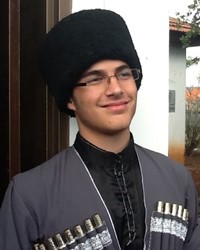The Circassians are the oldest indigenous people of Northwest Caucasus and identify themselves as Adyghe. The Adyghe preserve their culture and continue to use the Adyghe language as their primary means of communication. Only in the 18th century did their language assume a written form. Organized into tribes, the Adyghe have never had an independent state.
Once the Adyghe were the main ethnic element in northwest Caucasus; however, this drastically changed under the pressure of the Russian conquest, and especially after the defeat of the Great Revolt (1825-1864), when a Adyghe mass exodus took place. This exodus was called 'one of the greatest mass movements of population in modern history'. Adyghe moved to Turkey and other areas of the Ottoman Empire, including the Middle East. One and a half million Adyghe abandoned their ancient homeland, leaving behind scattered remnant communities. The Russian census of 1897 recorded only 150,000 Adyghe, less than one tenth of the original population. There are many stories, poems and songs about the victims of the war, the emigration itself and the state of exile. Rituals and memorial days are devoted to these events.
Much insight into Adyghe culture and customs can be gathered from their folk dances. The dances tell stories about everyday life such as courtship, preparing for war, the harvest, and showing of strength. All stories ultimately originate from the centuries-old Nart Epics, a series of 26 cycles and 700 texts dating back to 4,000-3,500 BC. The stories preserve Adyghe ancient history, and they are predecessors to Greek mythology, containing ancient stories of gods from southern Russia. From these Epics came the "Adyge habza," or Adyghe traditions.
The habza is an important feature of Adyghe identity and was established long before their Islamization. It is the Adyghe system of laws, rules, etiquette, and ethos. The habza provided the rules of behavior and morality that are handed down in other societies through religion. The Adyghe habza is passed on from generation to generation, with today's Adyghe youth still being taught to carry on the traditions.
Today, many Adyghe communities worldwide are facing the problems of losing their language and culture. Yet compared to other migrant groups, the Adyghe have a greater tendency to maintain their separate identity.
Many Adyghe were Christianized under Georgian and Byzantine influence in the 6th century. However, under the growing influence of the Ottomans, Islam gradually replaced Christianity and became fully established in the 18th and 19th century, blending with remnants of Christian beliefs and even pre-Christian folk beliefs. It seems that religious influence upon Adyghe collective identity, both in the past and in the present, has been limited and superficial. Some Adyghe became Muslims only during their mass migration, on the ships taking them to the other side of the Black Sea.
In recent years, Adyghe in the Caucuses region underwent an intensive process of secularization. In addition to the absence of mosques, there is a strong norm of consuming alcoholic drinks. A whole set of social customs and rituals derived from the pre-Islamic Adyghe culture has been revived.
The collapse of the Soviet Union heightened Adyghe national feeling both in Russia and in the diaspora. Since then, the Adyghe have forged links with their brethren all over the world. The state of exile in the diaspora plays an important role in the collective identity of Adyghe. A Adyghe proverb says: "The one who loses his homeland loses everything". Other examples of proverbs expressing the longing for the homeland are: "Caucasus, my homeland, I will never forget you"; or, "I'd rather lose my eyes than forget you". These and other similar statements are not only a romantic longing or nostalgia for the Caucasus homeland; they reflect the existential condition of the individual in the Adyghe community.
The re-migration of the Adyghe to the Caucasus is a new phenomenon and is continuing. The successful absorption of new immigrants will depend upon the situation in the Caucasus. Political instability, economic hardship and rising crime rates limit the number of newcomers.
Pray for the Holy Spirit to give the Adyghe people in Egypt a desire for truth and righteousness that will lead them to the cross.
Pray for changes in Adyghe society to lead them to desire Jesus Christ even more than they crave their own identity and homeland.
Pray for Adyghe disciples who will make more disciples.
Scripture Prayers for the Adyghe in Egypt.
| Profile Source: Joshua Project |
| Other PDF Profile |


























